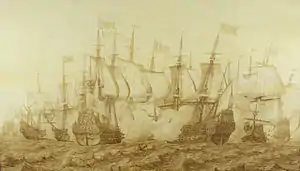Battle of the Gabbard
The naval Battle of the Gabbard,[lower-alpha 2] also known as the Battle of Gabbard Bank, the Battle of the North Foreland or the Second Battle of Nieuwpoort took place on 2–3 June 1653 (12–13 June 1653 Gregorian calendar).[lower-alpha 1] during the First Anglo-Dutch War near the Gabbard shoal off the coast of Suffolk, England between fleets of the Commonwealth of England and the United Provinces.
| Battle of the Gabbard | |||||||
|---|---|---|---|---|---|---|---|
| Part of First Anglo-Dutch War | |||||||
 The Battle of the Gabbard, 2 June 1653 by Heerman Witmont | |||||||
| |||||||
| Belligerents | |||||||
|
|
| ||||||
| Commanders and leaders | |||||||
|
George Monck Richard Deane † John Lawson William Penn |
Maarten Tromp Witte de With | ||||||
| Strength | |||||||
| 100 ships | 98 ships | ||||||
| Casualties and losses | |||||||
| 126 dead & 236 wounded |
6 ships sunk 11 ships captured 1,350 prisoners | ||||||
The battle
The English fleet had 100 ships commanded by Generals at Sea George Monck and Richard Deane and Admirals John Lawson and William Penn. The Dutch had 98 ships under Lieutenant-Admiral Maarten Tromp and Vice-admiral Witte de With, divided in five squadrons. On 2 June 1653 the Dutch attacked but were beaten back because the English employed line-of-battle tactics, making the Dutch pay a high price for attempting to board. The Dutch fleet, consisting of lighter ships, was severely damaged and lost two ships.
On 3 June the English were joined by Admiral Robert Blake, but Tromp decided to try again a direct attack though his ships were practically out of ammunition. A sudden lull however made his ships sitting ducks for the superior English guns. The Dutch were routed, the English chasing them until well in the evening, capturing many Dutch ships. The battle ended with the Dutch losing in total seventeen ships, of which six were sunk and eleven captured. The English lost no ships, but Deane was killed. Tactically this was the worst defeat in Dutch naval history with the exception of the Battle of Lowestoft; strategically the defeat threatened to be disastrous.
The victory meant that the English control over the English Channel, regained by the Battle of Portland in March after it had been lost in the Battle of Dungeness, was now extended to the North Sea. After the battle, the English imposed a blockade on the Dutch coast, capturing many merchant ships and crippling the Dutch economy . The fleets met again on 29–31 July 1653 (8–10 August 1653 Gregorian calendar) at the Battle of Scheveningen.
Ships involved
England
Red Squadron
|
Van Division
|
Centre Division
|
Rear Division
|
|
White Squadron
& others |
Blue Squadron
& others |
See also
- HMS Gabbard of the British Royal Navy was named in honour of the battle.
Notes
- During this period in English history dates of events are usually recorded in the Julian calendar, while those the Netherlands are recorded in the Gregorian calendar. In this article dates are in the Julian calendar with the start of the year adjusted to 1 January (see Old Style and New Style dates).
- In Dutch the battle is known as the Zeeslag bij Nieuwpoort.
- Sources: R. C. Anderson, "English Fleet-Lists in the First Dutch War,"The Mariner's Mirror, Vol. XXIV No.4, October 1938 .R. C. Anderson, List of English Naval Captains 1642-1660, 1964. William Laird Clowes, The Royal Navy: A History from the Earliest Times to the Present, Vol.II, 1898.